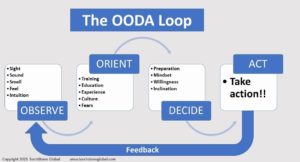
Avoiding the Deadly “Oh-Oh loop” with OODA
By TorchStone VP, Scott Stewart
For many years now, I’ve taught the concept of the OODA loop in security training courses. OODA is an acronym that stands for Observe, Orient, Decide and Act.
The concept of OODA was first developed during the Vietnam War by U.S. Air Force Col. John Boyd as a method to help his fellow pilots become more effective in dogfights. The system achieved its initial, narrow goal of shortening pilots’ decision and action processes, which resulted in a dramatic increase in dogfight success by American pilots during the war.
In subsequent years, people in other fields have recognized the merits of OODA and have applied it in a wide variety of nonmilitary settings, including corporate decision-making and medical triage procedures. The system is also a useful tool for enhancing personal security; and while law enforcement and security officers frequently receive OODA training, I believe civilians can also benefit from it.
OODA Loop
The process of consciously observing, orienting, deciding, and acting—the OODA Loop—creates links between an awareness of one’s surroundings in a dangerous situation and the actions necessary to escape it by staying one step ahead of an adversary. Because of this, I consider OODA to be the bridge that connects situational awareness with action.
I have often had students ask me, “but don’t people’s brains naturally work this way?” To which I answer, yes, as humans, we often unconsciously follow the pattern of OODA in reacting to stimuli. But by moving through this pattern consciously, people can accelerate the process and gain an advantage on opponents who are not engaging in deliberate OODA decision-making.
In other words, you can outmaneuver the OODA loop cycle of your adversary by processing through the cycle more rapidly. Furthermore, by making the process a conscious one, you are less likely to explain away or deny a warning sign that you may observe.
Finally, in many cases, people in stressful situations find themselves caught in what I call an “OO loop”—endlessly observing and orienting without making a decision or taking action. This quickly becomes an “Oh-Oh” loop because it allows their adversary to get inside their OODA loop cycle, often resulting in a very bad outcome. Consciously progressing through the OODA loop protects you from an Oh-Oh loop by forcing you to make a decision and then act.
Now, can sometimes the decision you make be to not act? Yes! But in such a situation you consciously made the decision not to act instead of being frozen in an Oh-Oh loop where you can’t act. There is a significant difference between these two states.
It is critical to recognize that in any dangerous situation OODA is not a one-time action but a continuous loop: As an adversary reacts to your actions, you must observe that reaction, and then rapidly orient, decide and act based on the reaction. The OODA cycle must continue in this manner until the situation is resolved.
Practicing OODA
First, despite its origins as a tool for fighter pilots, you don’t have to be a Top Gun ace to employ OODA. Like situational awareness, anyone can practice OODA if they have the will and discipline to do so.
Employing OODA does, however, take some practice, and one way to learn to use it is to consciously employ it during your everyday activities like driving to work, going shopping, taking a run, etc. Situational awareness complements OODA depending on the particular place and time. For example:
Observation: I am about to use an ATM on the street after dark.
Orientation: I know from experience, natural instinct, and security training I have received that this is a time and place of heightened danger. Because of this, I should consider increasing my situational awareness.
Decision: I am going to shift from a relaxed level of situational awareness into focused awareness.
Action: I watch out for danger.
Then, if you see something that catches your attention, you can run the OODA loop again.
Observation: Two men began to follow me after I left the ATM.
Orientation: I know robbery is common in this city and those men saw me leave the ATM. I don’t see any weapons or blatantly bad demeanor, but they could be potential muggers.
Decision: I need to continue to focus on them and do something to see if they are following me, or if they are just casual pedestrians.
Action: I pick up my pace and cross the street at the next intersection.
Then, based on the observation of how the two men react to your change of pace and street crossing, you will run your OODA loop again to decide whether you need to take further action and continue the OODA process, or if you can relax until something else causes you to begin your OODA process.
The concept of OODA may seem overly facile, but I have found that simple guidelines and processes are very helpful during tense situations. Stress, and the fight-or-flight response it provokes, has a discernible effect on human physiology.
One consequence is that blood rushes away from the brain to the limbs—often impairing rational thinking in the process. OODA is simple enough that a person can use it even under considerable duress—such as when one is in an aerial dogfight or caught in a confrontation with a street criminal. Plus, the experience of countless soldiers and law enforcement officers has proved that consciously running the OODA process can help keep the rational parts of your brain functioning, especially when combined with tactical breathing.
Unpacking OODA
The first “O,” Observe, is fairly straightforward. Observing is essentially practicing good situational awareness. The more observant you are of your surroundings, the more likely you are to notice and react to subtle signs of danger, rather than just the obvious ones. This often allows you to proactively spot emerging threats and avoid them, rather than just respond to them.
The second “O,” Orient, is a bit more complex. Orient doesn’t mean determining what direction to take as one does when orienting oneself using a compass. Rather, orienting in the practice of OODA entails placing yourself and your observations into the proper context considering your circumstances. This meaning of orient is the same one used to define a university orientation program designed to familiarize incoming students with their new environment.
Thus, in OODA, orienting is the process of quickly determining where you stand in relation to other actors in an ambiguous or rapidly changing situation. You conduct a rapid analysis using a number of filters such as education, training, experience, intuition, culture, upbringing, fears, and even faith, to put your observations into the appropriate context. It is this orientation process that equips you to quickly make a decision, “D”.
The “D,” Decision, is shaped by factors that include your preparation and mindset, as well as your willingness and inclination to do certain things. For example, you may have a deep personal conviction against conducting violence against another person, or against using potentially lethal force against someone for a purely economic crime. But ultimately, the decision step is critical because it is what prompts a person to act, “A” and saves them from being caught in an Oh-Oh loop.
In real-life situations, quite often the decision one makes may not be a “textbook” decision. But by acting and doing something—almost anything—you are forcing your assailant to react to your action, and if they are not consciously practicing OODA, you might be able to get inside their loop cycle.
A good example of this happened in 1987 when two of my former colleagues were ambushed on their way to work at the U.S. Embassy in Cairo. As they were sitting in an unarmored sedan in bumper-to-bumper morning rush hour traffic under a highway overpass, a gunman armed with an AK-47 opened fire on their vehicle. Unable to leave the attack zone and “get off the X” on the road due to stationary vehicles in front of and behind them, the driver stepped on the gas and pointed his car at the gunman on the sidewalk. As the vehicle jumped the curb, the gunman threw down his rifle and ran away. The two men were wounded but survived the incident. Had they sat there immobile and allowed the gunman to dump the rest of his magazine into their car, they likely would have died in the attack. But by quickly recognizing the attack (Observe) and by using the driver training he had been provided (Orient) the driver was able to make a split-second Decision and take the Action which saved both their lives. They had gotten inside their attacker’s loop and he was not prepared to respond to their unexpected action.
In addition to being a warrior, Col. John Boyd was a philosopher. He and many others have taken the OODA Loop to very complicated, metaphysical levels. I’m not suggesting that it is in any way wrong to try to map out these complex processes; the human brain, after all, is an extremely complex machine.
For the purposes of personal security, however, the OODA Loop’s greatest strength is its simplicity, how easily it enables people to observe activity by hostile parties, analyze the information, make appropriate decisions and quickly implement a course of action. If you can learn to consciously and rapidly process your observations, make rapid decisions, and then act on them—you will be way ahead of your opponent in almost any situation.

